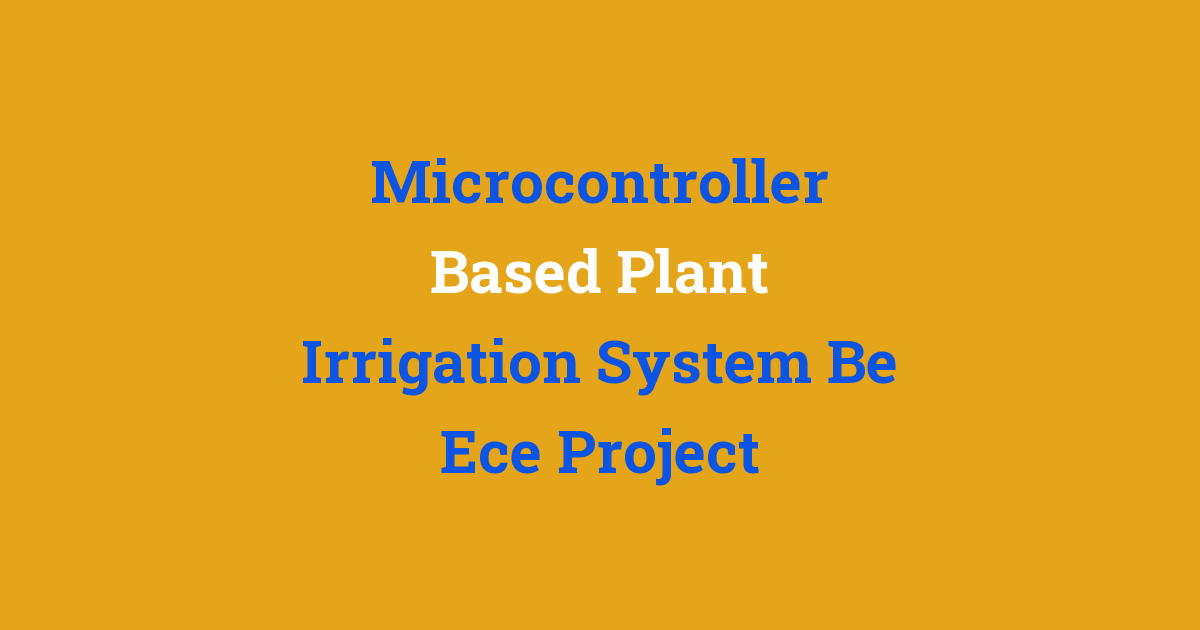An ECE project involves a microcontroller-based plant irrigation system.
Microcontroller-Based Plant Irrigation System ECE Project
Introduction
In recent years, the demand for automated irrigation systems has been increasing due to the growing need for efficient water management in agriculture. Traditional methods of manual irrigation are not only time-consuming but also are not suitable for large-scale farming. To address this issue, the use of microcontrollers in plant irrigation systems has gained popularity. Microcontroller-based irrigation systems offer several advantages such as automation, precision, and water conservation. In this project, we aim to design and implement a microcontroller-based plant irrigation system to improve the efficiency of irrigation in agriculture.
Problem Statement
The traditional method of plant irrigation involves manual labor and is often inefficient and wasteful. Farmers have to manually turn on and off the irrigation system, which can lead to over-watering or under-watering of plants. Moreover, the lack of real-time monitoring and control makes it challenging to optimize water usage. This results in increased water consumption, higher labor costs, and reduced crop yield. Therefore, there is a need for an automated system that can monitor soil moisture levels and irrigate plants accordingly.
Existing System
The existing plant irrigation systems rely on manual intervention and lack automation. Farmers have to rely on their intuition and experience to determine when and how much water to provide to their crops. This approach is not only inefficient but also time-consuming. Additionally, traditional irrigation systems do not consider the actual water requirements of plants, resulting in water wastage and increased operational costs. There is also a lack of real-time monitoring and control in the existing systems, making it difficult to optimize water usage.
Disadvantages
The disadvantages of the existing plant irrigation systems include:
– Inefficiency and wastage of water
– Manual intervention and labor-intensive
– Lack of real-time monitoring and control
– Increased operational costs
– Reduced crop yield due to under-watering or over-watering
Proposed System
The proposed system is a microcontroller-based plant irrigation system that utilizes sensors to monitor soil moisture levels and automatically irrigate plants when necessary. The system consists of a microcontroller, soil moisture sensors, water pumps, and valves. The microcontroller receives input from the sensors and activates the water pumps to irrigate plants based on predefined moisture thresholds. In addition, the system can be programmed to adjust irrigation scheduling based on the specific water requirements of different plant species.
Advantages
The advantages of the proposed microcontroller-based plant irrigation system include:
– Automation and efficiency in irrigation
– Real-time monitoring and control of soil moisture levels
– Precision in water delivery to plants
– Water conservation and reduced wastage
– Customizable irrigation scheduling for different plant species
Features
The key features of the microcontroller-based plant irrigation system are as follows:
– Soil moisture sensors for real-time monitoring
– Microcontroller for automated control of irrigation
– Water pumps and valves for water delivery
– Programmable logic for customizable irrigation scheduling
– User interface for monitoring and configuration
Conclusion
In conclusion, the proposed microcontroller-based plant irrigation system offers a practical solution to the inefficiencies of traditional irrigation methods. By automating the irrigation process and incorporating real-time monitoring and control, the system can optimize water usage, reduce operational costs, and improve crop yield. The integration of advanced technologies such as microcontrollers and sensors in agriculture is essential for sustainable and efficient farming practices. This project aims to demonstrate the feasibility and benefits of using microcontroller-based systems in plant irrigation and pave the way for future advancements in agricultural automation.

